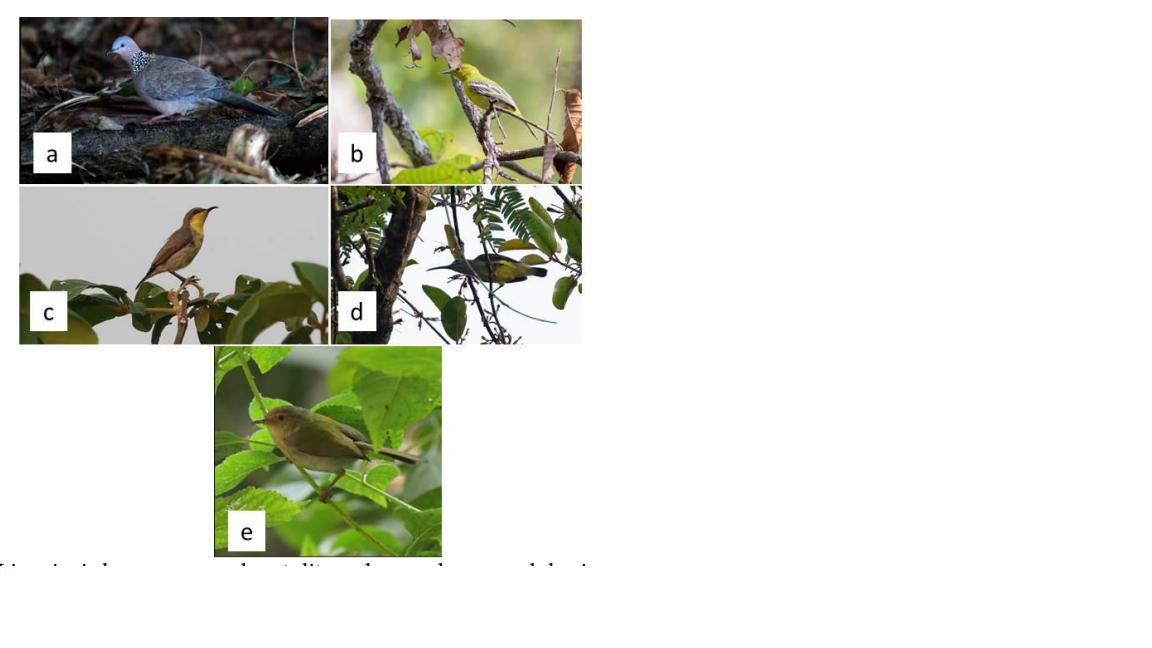Respon Komunitas Burung pada Daerah Tepi antara Tegakan Agathis dan Agroforestri di Hutan Pendidikan Gunung Walat, Sukabumi
DOI:
https://doi.org/10.22219/avicennia.v6i1.23320Keywords:
Bird communities, edge, Gunung Walat University ForestAbstract
Daerah tepi diartikan sebagai sebuah garis yang memisahkan dua ekosistem berbeda. Keberadaan daerah tepi dapat menciptakan habitat bagi spesies yang toleran terhadap daerah terbuka. Tujuan dari penelitian ini adalah untuk menganalisis spesies apa yang ditemukan di daerah tepi dan interior serta menganalisis bagaimana respon burung terhadap keberadaan daerah tepi. Survey burung dilakukan pada dua tipe habitat yaitu pada tegakan agathis dan agroforestri (daerah tepi dan interior) menggunakan metode titik hitung. Tercatat 35 jenis burung dari 22 famili yang teridentifikasi di Hutan Pendidikan Gunung Walat (HPGW). Kelimpahan dan kekayaan jenis burung tertinggi teridentifikasi di daerah tepi yaitu n = 310 individu dan S = 35 spesies. Komposisi komunitas burung teridentifikasi berbeda pada setiap tipe habitat. Terdapat 24 spesies burung yang dapat dipetakan menjadi 4 model respon burung terhadap kehadiran daerah tepi yaitu generalist-edge neutral, generalist-edge conspicuous, specialist-edge conspicuous, dan edge specialist. Adanya perbedaan respon terhadap keberadaan daerah tepi dipengaruhi oleh karakteristik habitat
Downloads
References
Alikodra, H.S., (2002). Wildlife Management Vol. 1. Bogor : Faculty of Forestry IPB University.
Bailey, J.A. (1984). Principles of Wildlife Management. Colorado: Colorado State University.
Baker, J., French, K.., Whelen, R. (2002). The edge effect and ecotonal species: bird communities across a natural edge in Southeastern Australia. Ecol. 83 (11), 3048-3059.
Batary, P., Fronczek,S., Normann, C., Scherber, C., Tscharntke, T., (2014). How do edge effect and tree species diversity change bird diversity and avian nest survival in Germany’s largest deciduous forest?. For Ecol Man. 319, 44-50.
Berry, L., (2001). Edge effect on the distribution and abundance in Southern Victorian Forest. Wild Res. 28 (3), 239-245.
Bibby, C., Jones, M, Marsden, S., (2000). Expedition Field Techniques Bird Surveys. London : Expedition Advisor Centre.
Segura, C., Ferriche, M., Pleguezuelos, J.M., Santos, X., (2007). Specialist and generalist species in habitat use: implications for conservation assesment in snakes. Journal of History, 1-10. DOI: 10.1080/00222930701664203.
FAO [Food and Agriculture organization]. (2005). Global Forest Resource Assesment 2005: Progress Toward Sustainable Forest Management, FAO Forestry Paper 147., Rome : Food and Agriculture organization.
Gani, D.S., (1993). Let the earth green: Professor acceptance speech. , Bogor : Faculty of Forestry IPB University.
Gregory, R.D., Gibbons, D.W., Donald, P.F., (2004). Bird census and survey techniques. In: Sutherland WJ, Newton I, Green RE (eds) Bird Ecology and Conservation; A Handbook of Techniques. Oxford : Oxford university Press.
Handoyo, F., Hakim, L., Leksono, A.S., (2016). Analisis potensi runag terbuka hijau Kota Malang sebagai areal pelestarian burung. J-PAL 7 (2), 86-95.
Kartikasari, D., Pudyatmoko, S., Wawandono, N. B., Utami, P., (2018) Respon komunitas burung terhadap pembangkit listrik tenaga panas bumi (PLTP) Kamojang Bandung, Jawa Barat. Jurnal Ilmu Kehutanan 12 (2), 156-171. https://doi.org/10.22146/jik.40145
Lidicker, W.Z., Koenig, W.D., (1996). Responses of terrestrial vertebrates to habitat edges and corridor. In: McCullough DR (eds) Metapopulation and Wildlife Conservation. Washington : Island Press.
MacKinnon, J., Phillips, K., Van Balen, B., (2010). Field guide of birds in Sumatera, Java, Bali and Kalimantan. Bogor : Burung Indonesia.
Mardiastuti, A., (2015). Animal ecology in human-dominated landscapes. Bogor: Faculty of Forestry IPB University Press.
Miller., (2010). The role of birds in maintaining the ecosystem. www.ehow.com/facts_5452359-role-birds-maintaining-ecosystem.html.
Mulyani, Y.A., Haneda, N.F., Purnomo, H., Kaban, A., (2020). Insectivorous bird in edge and interior habitats of Forest Plantation in Gunung Walat Sukabumi. IOP Conf. Ser. Earth. Environ. Sci. 528 012026.
Murcia, C., (1995). Edge effects in fragmented forests: implication for conservation. Trends Ecol. 10, 58-62.
Nababan, B.R.R., Harianto, S.P., Setiawan, A., (2021). Diversitas spesies burung dalam penentuan kualitas Ruang Terbuka Hijau di Universitas Lampung. Jurnal Hutan Tropis 9 (1), 30-42.
Novarino, W., (2008). Dinamika jangka panjang komunitas burung srata bawah di Sipisang, Sumatera Barat. [Disertasi]. Bogor: IPB University.
Odum, E.P., (1958). Fundamental of Ecology 2nd Edition. Philadelphia: Saunders.
Rianto, A., Darmawan, A., (2022). Keanekaragaman amfibi pada lahan agroforestri di Pekon Kotabatu, Tanggamus, lampung. Journal of Forest Science Avicennia 5 (01), 58-65.
Soendjoto, M.A., Gunawan., (2003). Keragaman burung di enam tipe habitat PT Inhutani I Labanan Kalimantan Timur. Biodiversitas 4 (2), 103-111.
Stephens, S.S., Koons, D.N., Rotella, J.J., Willey, D.W., (2003). Effects of habitat fragmentation on avian nesting success: A review of evidence at multiple spatial scales. Biol Conserv. 111, 101-110.
Sukmantoro, W., Irham, M., Novarino, W., Hasudungan, F., Kemp, N., Muchtar, M., (2007). Indonesian Bird List No. 2. Bogor: Indonesian Ornithologist’ Union.
Susilo, A., Putri I.A.S.L.P., (2018). Respons burung bawah tajuk terhadap system pengelolaan TPTI dan TPTII/SILIN. Jurnal Penelitian Hutan dan Konservasi Alam 5 (2), 91-109.
Tamnge, F., Mulyani, Y.A., Mardiastuti, A., (2016). Efek tepi pada komunitas burung antara tegakan agathis dan puspa Hutan Pendidikan Gunung Walat, Jawa Barat. Media Konservasi 21 (1), 83-90.
Ulfah, M., Fajri, S., Hamsah, K., Purnawan, S., (2019). Diversity, evenness and dominance index reef fish in Krueng Raya Water, Aceh Besar. IOP Conf. Series: Earth and Environmental Science 348 (2019) 012074, 1-5.
Wiens, J.A., (1989). The Ecology of Bird Communities. Cambridge: Cambridge University Press.
Yoza, D., (2006). Diversity of bird species in various types of edge areas of The Sultan Syarif Hasyim Forest Park, Riau Province. [Theses]. Bogor: IPB University

Downloads
Published
Issue
Section
License
Copyright (c) 2023 Fadila Tamnge, Yeni Aryati Mulyani, Ani Mardiastuti

This work is licensed under a Creative Commons Attribution 4.0 International License.
Authors who publish with this journal agree to the following terms:
- Authors retain copyright and grant the journal right of first publication with the work simultaneously licensed under a Creative Commons Attribution License that allows others to share the work with an acknowledgement of the work's authorship and initial publication in this journal.
- Authors are able to enter into separate, additional contractual arrangements for the non-exclusive distribution of the journal's published version of the work (e.g., post it to an institutional repository or publish it in a book), with an acknowledgement of its initial publication in this journal.
- Authors are permitted and encouraged to post their work online (e.g., in institutional repositories or on their website) prior to and during the submission process, as it can lead to productive exchanges, as well as earlier and greater citation of published work (See The Effect of Open Access).










